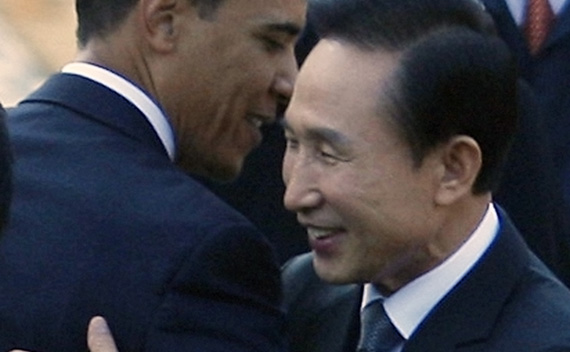The Missing Piece in the U.S.-Korea Summit: Implementation of the 2009 Joint Vision Statement
More on:

With the formal ratification of the Korea-U.S. Free Trade Agreement (KORUS-FTA) and a rare address by a South Korean president to a joint session of the U.S. Congress, the mood surrounding Lee Myung-bak’s state visit has turned celebratory. Indeed, this is a high point in the U.S.-ROK relationship, especially given the close personal relationship between President Lee and President Obama. But there has been a missing element in many pre-summit briefings in advance of this week’s state visit: the need for a progress report on implementation of the June 2009 U.S.-ROK Joint Vision Statement, touted as the major accomplishment of Lee’s last visit to the White House.
While ratification of the KORUS-FTA after such a long delay is a significant achievement, and there is a perennially urgent need for coordination regarding North Korea, the 2009 Joint Vision Statement represented an ambitious effort to cement an enduring and comprehensive U.S.-ROK alliance partnership. It provided a platform for the alliance to take on global and regional roles that extend the U.S.-ROK partnership well beyond the Korean peninsula, in line with expanded South Korean capacities and interests represented by the idea of a “global Korea.” But the absence of reference to the Joint Vision Statement in pre-summit briefings for the state visit either undersells the level of progress in implementing broadened U.S.-ROK cooperation or it diminishes the significance of this landmark statement by the two presidents as a platform for extending such cooperation.
The Joint Vision Statement envisioned closer cooperation on a laundry list of issues, including counter-terrorism, proliferation of weapons of mass destruction, space, anti-piracy, peacekeeping, post-conflict stabilization, and development assistance. As a means by which to explore practical ways in which such cooperation might be further developed in each of these areas, I commissioned chapters for a forthcoming edited volume entitled The U.S.-South Korea Alliance: Meeting New Security Challenges to be published in February of next year. (As a bonus to attentive readers of this blog, I will provide free copies of the book upon publication to the first ten people who request a copy from me at [email protected]!)
The volume reveals that while the United States and South Korea have expanded cooperation to many new spheres of international security, the risk inherent in the global scope of the Joint Vision Statement is that it could potentially be used to justify the need for a U.S.-ROK alliance contribution to virtually any issue without regard to capabilities or priorities within the alliance. The expanded scope of envisioned cooperation within the alliance would become meaningless unless the capabilities are present and available to implement—and institutionalize—such cooperation. The building of an institutional framework for extending such cooperation is the missed opportunity that the two governments should have capitalized during the past two years at an historic high point in the relationship.
My book recommends that the United States and South Korea build a “whole of alliance” approach to coordination in support of shared objectives, that the United States and South Korea develop a division of labor in promoting shared alliance objectives based on comparative advantage, that both governments build broad domestic public support for alliance-based cooperation, that the two countries recognize the need to balance global and regional cooperation with the imperative of maintaining close coordination toward North Korea, and that the U.S.-ROK alliance capabilities be integrated with other U.S.-led alliance frameworks as a platform for promoting regional and global stability.
In a straitened U.S. fiscal environment, it will be natural to question whether the resources are available to truly promote a global and regional vision for the U.S.-ROK alliance. But limited resources may also be a factor that necessitates cooperation on global security issues, given that instability may impose even higher costs and risks to shared national interests. While personal relations between the two presidents are positive, there should be a strong push for progress in buttressing the relationship against the inevitable challenges on the horizon.
More on:
 Online Store
Online Store
